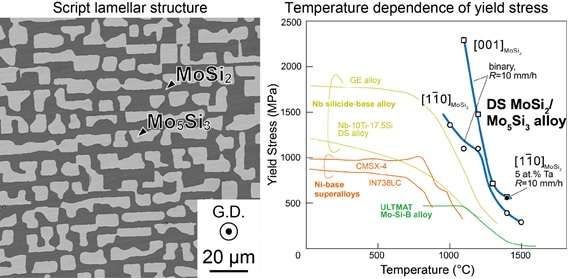Stronger turbine blades with molybdenum silicides

Researchers at Kyoto University have found that molybdenum silicides can improve the efficiency of turbine blades in ultrahigh-temperature combustion systems.
Gas turbines are the engines that generate electricity in power plants. The operating temperatures of their combustion systems can exceed 1600 °C. The nickel-based turbine blades used in these systems melt at temperatures 200 °C lower and thus require air-cooling to function. Turbine blades made out of materials with higher melting temperatures would require less fuel consumption and lead to lower CO2 emissions.
Materials scientists at Japan's Kyoto University investigated the properties of various compositions of molybdenum silicides, with and without additional ternary elements.
Previous research showed that fabricating molybdenum silicide-based composites by pressing and heating their powders – known as powder metallurgy – improved their resistance to fracturing at ambient temperatures but lowered their high-temperature strength, due to the development of silicon dioxide layers within the material.
The Kyoto University team fabricated their molybdenum silicide-based materials using a method known as "directional solidification," in which molten metal progressively solidifies in a certain direction.
The team found that a homogeneous material could be formed by controlling the solidification rate of the molybdenum silicide-based composite during fabrication and by adjusting the amount of the ternary element added to the composite.
The resulting material starts deforming plastically under uniaxial compression above 1000 °C. Also, the material's high-temperature strength increases through microstructure refinement. Adding tantalum to the composite is more effective than adding vanadium, niobium or tungsten for improving the strength of the material at temperatures around 1400 °C. The alloys fabricated by the Kyoto University team are much stronger at high temperatures than modern nickel-based superalloys as well as recently developed ultrahigh-temperature structural materials, the researchers report in their study published in the journal Science and Technology of Advanced Materials.
More information: Hirotaka Matsunoshita et al. Plastic deformation of directionally solidified ingots of binary and some ternary MoSi/MoSieutectic composites, Science and Technology of Advanced Materials (2016). DOI: 10.1080/14686996.2016.1218248
Journal information: Science and Technology of Advanced Materials
Provided by Kyoto University

















